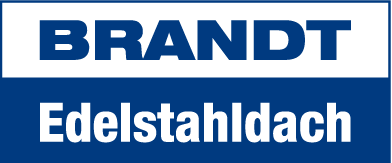Stainless steel, a material that matured enormously
1912 was a bad year for rust
By combining nickel and chrome in combination with an exactly regulated heat treating it succeeded to generate a material that persuades people of its corrosion resistance and good mechanic properties. That is how stainless steel got more and more attractive for roofing and roof drainage in building construction. One talks about stainless steel if the chrome concentration is at least 10,5%. Stainless steel in building construction developed enormously. There are different surfaces that can diversify depending on the requirements. Tinned, bright and matt-finished stainless steels are very strong. Further useful information about stainless steel you can get on the homepage of ISER – Informationsstelle Edelstahl Rostfrei, which is an information centre about rust-proof stainless steel.
Significant advantages of stainless steel in building construction:
Cost saving
Little material thickness (0,4mm / 0,5mm) with equal or even better quality properties, for example better tenacity or less expansion coefficient detracts weight/m². Because of the little dead weight one can roof a much bigger surface with stainless steel: up to 75% depending on comparison reasons
Weather independent processing
Stainless steel can even be processed on cold days and does not show any cold shortness like other materials do. “As long as the processor is able to work the material works with him.
Material combinations
Rust-proof steel is compatible with all kinds of wood (chip trays, hardboards, etc.). Furthermore it is constant against cement and cold mortar and does not build contact corrosion in combination with zinc, copper and other metals in building construction besides rust or unprotected steel.
Environmental safety
Rust-proof steel and tin are absolutely environmentally safe and hundred per cent recyclable. They do not underlie removals so that no particles pollute the environment.
Passive layer on stainless steel
Rust-proof stainless steel is alloyed with at least 10,5% chrome and contains less than 1,2% carbonate. Under oxygen exposure a solid oxide coating (passive layer) is built which protects the material against corrosion.
100 years stainless steel
The development of rust-proof stainless steel proceeds
In the middle of the 1920´s stainless steel was already well known in processing of home and kitchen devices.
The induction of the Chrysler Building in 1930 became the break-through as material for fronts and roofing. Its pyramidal tower roof with seven bows and triangular windows as well as the pyramidal top are cased with stainless steel and draw the attention of every New York visitor – in spite of all other skyscrapers of the popular skyline.
Main reason for using the material was its stability against atmospheric influences – no matter of which kind. Besides the owner was impressed that the bright surface was going to stay and the Chrysler Building would be the “brightest crown” of New York for a very long time. How right the decision for stainless steel as an unbreakable material has been one could see during cleaning work decades later: The material did not show any corrosion damages and sparkled again like it did at the beginning.
In Germany it was a long way until stainless steel became accepted. BRANDT Edelstahldach GmbH was significantly involved in developing appropriate DIN/EN standards, offered and still offers trainings at schools or fairs and consequently stands up for the material. Participants still remember tough discussions about material thicknesses which were chosen too thick by means of standards. One discussed about thicknesses of 0,7mm and more, but stainless steel manages with 0,4mm – 0,5mm and same quality standards. What once was a handicap for acceptance is one of the most important arguments today: the thin material thickness at same quality standards reduces the weight per m² essentially opposite to traditional materials for roofing, roof drainage, etc., which is an enormous cost benefit in restoration of old or even landmarked building fabric. Restoration measures often go without statics work because of intact carriers. Not to mention the corrosion resistance as well as the accompanying durability as cost factor.


